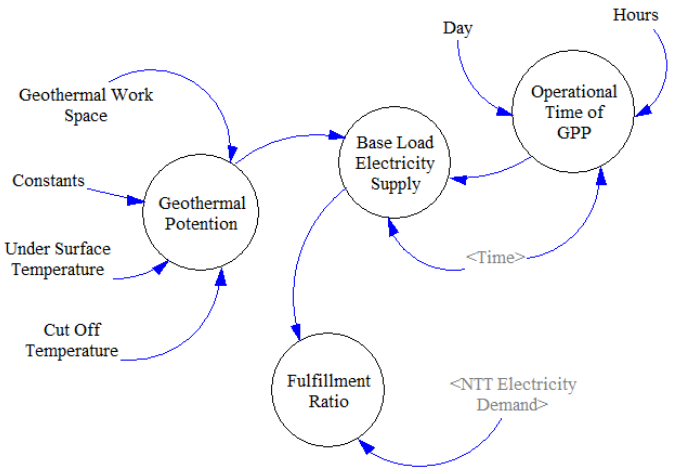Mataloko Geothermal Power Plant Development Strategy in order to Maintain the Sustainability of Supply and Demand Electric Energy in Kupang, East Nusa Tenggara (A System Dynamics Framework)
DOI:
https://doi.org/10.24273/jgeet.2017.2.3.488Keywords:
Geothermal Power System, Renewable Resource, Electrification Ratio, Supply and Demand, System DynamicsAbstract
One of Indonesia’s problem as an archipelagic country is unequally electrification ratio, especially in Indonesia eastern region. In 2015, the electrification ratio in Kupang is 58.67%. This figure is far below from Indonesia electrification ratio, which is 88.3%. At present, people of Kupang get their electricity supply from fuel energy power system, which is costly and has a bad impact for environment. Furthermore, Indonesia has many renewable resource that has not been fully utilized and this condition in line with acceleration program of electricity infrastructure development in Indonesia, considering that Kupang has a geothermal potential in Mataloko. This research aims to develop a dynamical model of Mataloko geothermal power plant 1 x 2.5 mw development strategy in Kupang, East Nusa Tenggara from technical and economical aspect. We used system dynamics to modelling the existing electricity condition in Kupang as a base model to develop scenarios. We hope this scenario can be taken as consideration to develop a renewable resource power plant in order to fulfill the electricity demand. The result shows that geothermal potential in Mataloko is feasible to generate an electricity
Downloads
References
Boldizàr, T., 1943. Aspect of Geothermal Gradient in Mining Industry (In Hungarian). Budapest: BKL 20.
BPS_NTT, 2016. Nusa Tenggara Timur Province in Figures. Nusa Tenggara Timur: BPS-Statistics of Nusa Tenggara Timur.
Forrester, J. W., 1968. Principle of System. Massachusettss: Wright-Allen Press Inc..
Hanindhito, S., Mahmudsyah, S. & Yuwono, T., 2011. Studi Pembangunan PLTP Guci 1 x 55 mw Jawa Tengah Berdasarkan Aspek Teknis, Ekonomi dan Lingkungan.
PLN, 2016. [Online] Available at: http://www.pln.co.id
Rahawuryan, F., Marsudi, S. & Purwati, E., 2015. Studi Kelayakan Perencanaan Plta Kesamben Kabupaten Blitar Jawa Timur s.l.: s.n.
Santoso, P., 1997. Kajian Keekonomian Dan Kebijakan Pengusahaan Sumber Daya Energi Panas Bumi Untuk Pembangkitan Listrik Skala Kecil Di Indonesia.
Suryani, E., 2006. Pemodelan dan Simulasi. Yogyakarta: Graha Ilmu.
Tama, R. G., 2012. Studi Pengembangan Pembangkit Listrik Tenaga Panas Bumi (Pltp) Di Jailolo Untuk Memenuhi Kebutuhan Listrik Di Maluku Utara. Proceeding Seminar Tugas Akhir Jurusan Teknik Elektro FTI-ITS..
Toth, A. & Bobok, E., 2017. Flow and Heat Transfer in Geothermal Systems. Miskolc: elsevier.
Winardi, 1989. Pengantar Tentang Teori Sistem dan Analisis Sistem. Bandung: Mandar Maju.

Downloads
Published
Issue
Section
License
Copyright @2019. This is an open-access article distributed under the terms of the Creative Commons Attribution-ShareAlike 4.0 International License which permits unrestricted use, distribution, and reproduction in any medium. Copyrights of all materials published in JGEET are freely available without charge to users or / institution. Users are allowed to read, download, copy, distribute, search, or link to full-text articles in this journal without asking by giving appropriate credit, provide a link to the license, and indicate if changes were made. All of the remix, transform, or build upon the material must distribute the contributions under the same license as the original.










